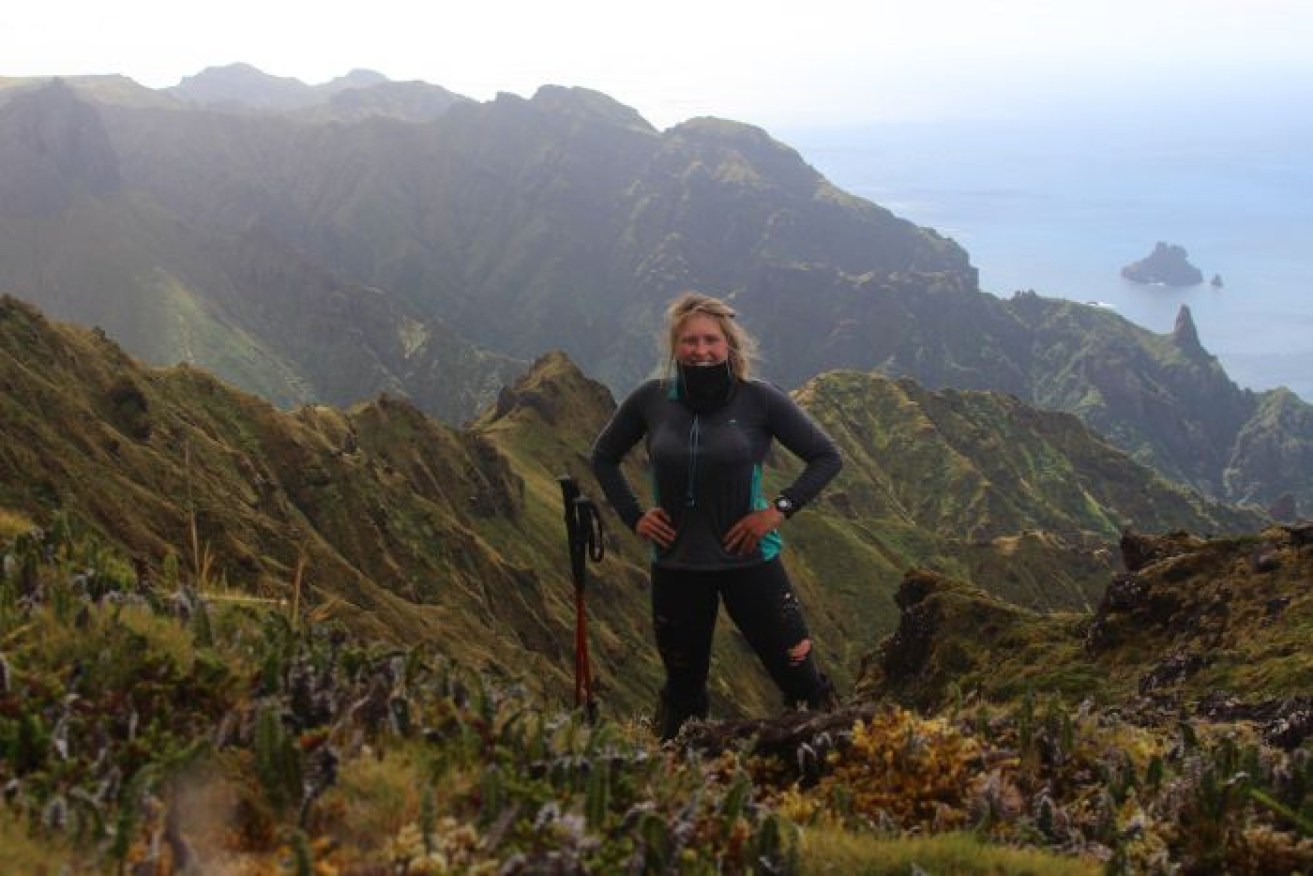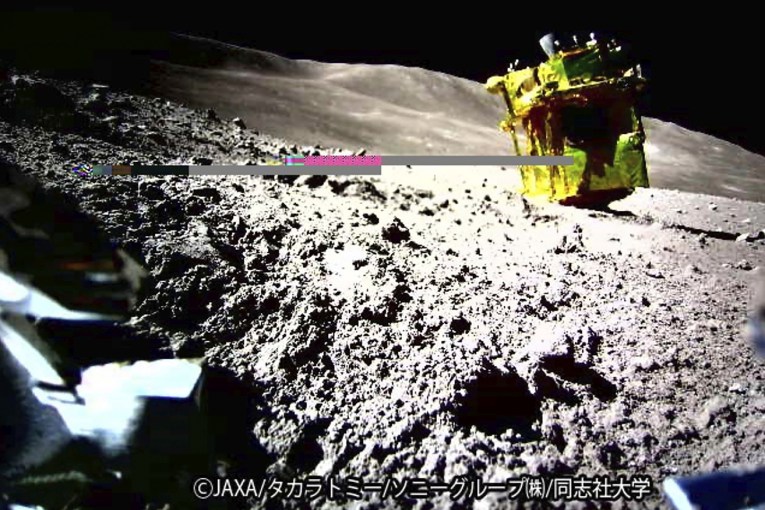Giant Tristan albatross faces being wiped out by a tiny predator – the house mouse

Dr Jaimie Cleeland has spent a year on Gough Island studying its threatened seabirds. Photo: Jaimie Cleeland
Welcome to Gough Island, one of the most remote rocks on the planet.
The steep, volcanic island mountain sits about 3000 kilometres from South Africa and 3000 kilometres from South America and receives around three metres of rainfall every single year, making it luscious and verdant.
As one of the only blobs of land in an area of fertile ocean upwellings, Gough is a seabird nesting island: A solid place to build a nest, with plentiful food nearby.
Accordingly, millions of seabirds nest every year on Gough Island.
It’s a bird person’s dream and nightmare in one.
The toll of loving an endangered species
The bird person in question is Australian marine ecologist Jaimie Cleeland – an albatross expert who recently spent a year with the Royal Society for the Protection of Birds (RSPB) on Gough Island in the South Atlantic.
She’s the sort of scientist they write picture books about.
One minute she’s on one of the most remote islands in the world monitoring nesting albatross, operating a crane to hoist researchers up a cliff, then seemingly the next minute she’s off to drive a barge in Antarctica, offloading yearly supplies from an icebreaker to a base.
But adventurous as it may be, her job is tough, physically and emotionally.
“We had a week on Gough where we lost 15 albatross chicks in a row,” Dr Cleeland says.
“We had a Tristan albatross turn up with a long line hook caught in its beak.
“And then we had one of our chicks turn up in Rio with a thong in its stomach.
“I’m getting shivers now … It’s terrible.”
Size isn’t everything for this unlikely predator
But the biggest factor in chick mortality on Gough Island is tiny little mice.
It was sub-Antarctic fur seals and elephant seals that lured sealers to the remote island in the 19th century, but their lasting legacy lies on in a much smaller mammal – the invasive house mouse.
The nocturnal mammals attack at night, when the chicks are sleepy and tired, and climb up the nest and onto the back of the fluffy juvenile albatross.
The chicks, who dwarf the mice considerably, will swat them away at first.
But the mice are persistent.
“After a few hours of this, the chick gets tired and the mice get an opportunity to create a small wound,” Dr Cleeland says.
“It might take several hours, and it might take several mice, but that wound gets bigger and bigger and eventually causes the death of the albatross chick.”
Watching the mice overcome the albatross chicks is distressing, and quicker than you might think.
“The whole process from when we saw that first mouse to when the albatross chick was killed was about an hour,” Dr Cleeland says.
“I don’t think I processed it straight away. The next morning I woke up and I just felt completely deflated.
“I also felt a lot of energy and anger in a way. I just had to do something.”
Mice are responsible for two million chick deaths every year on the island, and it’s not just albatross.
They also prey on prions, petrels, shearwaters and other seabirds, as well as the endemic Gough moorhen and bunting.
For some species, like the critically endangered Tristan albatross, this island is the only viable nesting colony in the world.
A long-lived, loyal giant
Tristan albatross are almost indistinguishable from wandering albatross – they’re just a bit smaller. Their wingspan is “only” three metres wide.
They nest on a high plateau of low herbaceous foliage, an almost vertical 2.5-hour hike from the base.
The researchers call this special place Gonydale, because sailors used to call these birds Gonys.
Once a year, these winged monsters fly in from the wide ocean to meet and greet each other, repair their mud-plinth nests and try to raise a chick.
They live for decades and it’s only after at least seven years, sometimes up to 15 years, that they’ll be mature and ready to settle down to nest.
Before that, they spend the breeding seasons loafing in the colony on Gough, learning how to be an adult albatross, observing what goes on and dating each other.
When the time finally comes to breed they’re most likely to breed with an individual that they’ve built a relationship with through their teenage years, and their dedication to their family knows no bounds.
“When these Tristan albatross lay an egg they have this incredible bond with that egg. And they will sit on that egg until their partner comes back.”
Even the adults are being attacked by mice as they care for their precious eggs.
“This is something quite new that we’ve seen, and it has much greater consequences for the population – it’s no longer just the chicks,” Dr Cleeland says.
The latest population estimate for Tristan albatross indicates that, without radical intervention, the species will be extinct in 20 years.
Super-mice sharing knowledge
But how can such a tiny predator bring down the mightiest of birds?
The mice on Gough will attack birds that are up to 300 times their own size and over the past several hundred years, the mice have grown to be 50 per cent bigger than what we see on mainland Australia.
“They’re super-mice,” Dr Cleeland says.
“This behaviour of eating seabirds alive probably developed because the area around the nest where there’s a lot of albatross poo also has a lot of invertebrates, such as caterpillars and other insects.
“The mice would’ve been eating the invertebrates and then slowly worked out ‘Oh, there’s another food source here’.”
The seabird chicks, after tens of thousands of years without seeing anything like the house mouse, are unable to shoo it away consistently — they just don’t know how to react to the sustained assault, especially at night when they’re sleepy.
“But climate change comes into it as well,” Dr Cleeland says.
Warmer, drier summers likely lead to higher mouse populations, and more desperation from the mammals to find food.
Scientists are also investigating if the mice learn the behaviour of attacking chicks from each other.
“We used to see these really cold winters where the mice population would be knocked back quite significantly, so the capacity for this knowledge to be shared among these mice is much harder,” she says.
“Now we see it’s a bit warmer, more mice are surviving through the winter, so they’re being able to pass on that knowledge more quickly and effectively.
“And we’re seeing whole areas where all the chicks are gone.”
The RSPB, which helps manage the island, will start a mouse eradication program in 2020 where they will use helicopters to spread mouse bait over the entire island.
The non-profit organisation is fundraising to hit its target of about $16 million, as the mission to rid the island of rodents is logistically and technically very difficult.
It will take several years, perhaps even decades to see a boost in some birds on the island, as fledglings such as the Tristan albatross might be 14 years old before they’re ready to become a parent.
But when they do, it will be bliss for this bird person.
“That’s the big driver for me, is just seeing the island after the mice are gone,” Dr Cleeland says.

















